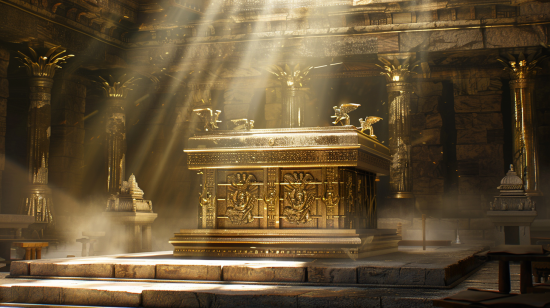Introduction
The Ark of the Covenant, a biblical artifact said to contain the Ten Commandments, has been missing for centuries. Legends and theories about its location range from hidden in a secret chamber in Jerusalem to being taken to Ethiopia. Its true location remains a mystery, captivating historians, archaeologists, and religious scholars alike.
Biblical Description
The Ark of the Covenant is described in the Bible as a sacred chest made of acacia wood, covered in gold, and adorned with two cherubim on its lid. It was built under the direction of Moses, following specific instructions given by God. The Ark held the stone tablets of the Ten Commandments, Aaron’s rod, and a pot of manna, symbolizing God’s covenant with the Israelites.
The Ark’s Journey in the Bible
The Ark’s journey began with the Israelites in the desert, where it was carried during their wanderings and conquests. It played a pivotal role in battles, symbolizing God’s presence and power. The Ark was eventually housed in the Tabernacle and later brought to Jerusalem by King David, who intended to build a permanent temple for it.
The Ark in Solomon’s Temple
King Solomon, David’s son, constructed the First Temple in Jerusalem, where the Ark was placed in the Holy of Holies, the temple’s innermost sanctuary. It remained there, central to Israelite worship and ceremonies, until the temple’s destruction.
Disappearance of the Ark
The Ark’s disappearance is shrouded in mystery. It is believed to have vanished around the time of the Babylonian conquest of Jerusalem in 586 BCE, when the First Temple was destroyed. Some theories suggest it was hidden to protect it from invaders, while others propose it was taken by conquerors.
Legends and Theories on the Ark’s Location
Numerous legends and theories have emerged over the centuries regarding the Ark’s whereabouts. These range from it being hidden in secret tunnels beneath Jerusalem to being transported to far-off lands. The mystery has spurred countless searches and much speculation.
The Ethiopian Theory
One of the most intriguing theories suggests that the Ark was taken to Ethiopia. According to Ethiopian tradition, the Ark resides in the Church of Our Lady Mary of Zion in Axum. This theory is supported by Ethiopian religious texts and the enduring belief of the Ethiopian Orthodox Church.
The Jerusalem Theory
Another popular theory posits that the Ark remains hidden somewhere in Jerusalem. Proponents believe it could be buried beneath the Temple Mount or in other ancient chambers yet to be discovered. Archaeological searches have been conducted, but no definitive evidence has been found.
Other Proposed Locations
Other theories suggest that the Ark might be in various locations, including southern Africa, Europe, or even hidden within the Vatican’s secret archives. Each of these theories is based on historical interpretations, legends, and sometimes scant evidence.
Modern Searches for the Ark
Modern expeditions and researchers have attempted to locate the Ark using advanced technology and historical analysis. Notable searches have been conducted in Ethiopia, Jerusalem, and other potential sites. Despite these efforts, the Ark’s location remains undiscovered.
The Ark in Popular Culture
The Ark of the Covenant has left a significant mark on popular culture. It has been featured in numerous books, films, and art, most famously in the movie “Raiders of the Lost Ark.” These portrayals often blend fact and fiction, adding to the Ark’s mystique.
Religious Significance Today
The Ark continues to hold profound religious significance for Jews, Christians, and others. It symbolizes God’s covenant and presence, and its story is an essential part of religious teachings and traditions.
Scientific and Historical Analysis
Verifying the Ark’s existence poses significant challenges. Scientific methods such as ground-penetrating radar and historical document analysis are used in the search. However, the lack of physical evidence makes definitive conclusions elusive.
Criticism and Skepticism
Many scholars and skeptics question the veracity of the Ark legends. They argue that the stories are a blend of myth and historical exaggeration. Proponents of the Ark’s existence counter that the lack of evidence does not disprove its existence but rather highlights the need for continued exploration.
The Enduring Mystery
The Ark of the Covenant continues to fascinate because of its deep historical, religious, and cultural significance. It embodies the intersection of faith, history, and mystery, captivating those who seek to uncover its secrets.
Conclusion
The mystery of the Ark of the Covenant endures, with its location and fate remaining unknown. Its story, rich with religious significance and historical intrigue, continues to inspire and challenge those who seek to understand this ancient artifact’s true history and significance.
FAQs
What is the Ark of the Covenant?
The Ark of the Covenant is a biblical artifact said to contain the Ten Commandments, Aaron’s rod, and a pot of manna. It was a sacred chest built under the direction of Moses.
Why is the Ark of the Covenant important?
The Ark symbolizes God’s covenant with the Israelites and His presence among them. It played a central role in their religious ceremonies and battles.
Where do people think the Ark is now?
Theories about the Ark’s location include hidden chambers in Jerusalem, a church in Ethiopia, and various other locations around the world.
Has anyone found the Ark of the Covenant?
Despite numerous searches and claims, the Ark has never been definitively found, and its location remains a mystery.
Why does the Ark of the Covenant continue to fascinate people?
The Ark’s blend of religious significance, historical mystery, and cultural impact makes it a subject of enduring fascination and intrigue.

